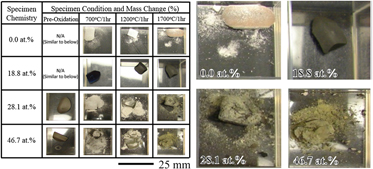Crossref Citations
This article has been cited by the following publications. This list is generated based on data provided by
Crossref.
Wen, Qingbo
Riedel, Ralf
and
Ionescu, Emanuel
2018.
Significant improvement of the short-term high-temperature oxidation resistance of dense monolithic HfC/SiC ceramic nanocomposites upon incorporation of Ta.
Corrosion Science,
Vol. 145,
Issue. ,
p.
191.
McCormack, Scott J.
Tseng, Kuo‐Pin
Weber, Richard J. K.
Kapush, Denys
Ushakov, Sergey V.
Navrotsky, Alexandra
and
Kriven, Waltraud M.
2019.
In‐situ determination of the HfO2–Ta2O5‐temperature phase diagram up to 3000°C.
Journal of the American Ceramic Society,
Vol. 102,
Issue. 8,
p.
4848.
Wen, Qingbo
Riedel, Ralf
and
Ionescu, Emanuel
2019.
Solid‐Solution Effects on the High‐Temperature Oxidation Behavior of Polymer‐Derived (Hf,Ta)C/SiC and (Hf,Ti)C/SiC Ceramic Nanocomposites.
Advanced Engineering Materials,
Vol. 21,
Issue. 5,
Young, Catalina
Zhang, Cheng
Loganathan, Archana
Nautiyal, Pranjal
Boesl, Benjamin
and
Agarwal, Arvind
2020.
Densification and oxidation behavior of spark plasma sintered Hafnium Diboride-Hafnium Carbide composite.
Ceramics International,
Vol. 46,
Issue. 10,
p.
14625.
Moslemi-firoozabadi, Hamidreza
Manafi, Sahebali
and
Ghahremani, Davoud
2022.
Microstructure and properties evolution of spark plasma sintered mullite-CNT composite with HfN addition.
Journal of the Australian Ceramic Society,
Vol. 58,
Issue. 5,
p.
1481.
Manafi, Sahebali
2022.
Preparation of Mullite-Hfn Composites Through Spark Plasma Sintering: Investigation of Microstructure and Mechanical Properties.
SSRN Electronic Journal ,
Moslemi-firoozabadi, Hamidreza
Manafi, Sahebali
and
Ghahremani, Davoud
2022.
Preparation of mullite-HfN composites through spark plasma sintering: investigation of the microstructure and mechanical properties.
Journal of the Korean Ceramic Society,
Vol. 59,
Issue. 6,
p.
775.
Tan, Z.Y.
Wu, X.
Guo, J.W.
and
Zhu, W.
2023.
Toughness mechanism and plastic insensitivity of submicron second phase Ta in a novel Ta–Hf6Ta2O17 composite ceramic.
Ceramics International,
Vol. 49,
Issue. 2,
p.
1932.
Wang, Shuai
Li, Ruoyu
Shi, Ruxing
Wang, Haodong
Sun, Xiaohong
Yu, Xingsheng
Yu, Chun
and
Xu, Jijin
2024.
In-situ N-doping to improve wear and corrosion resistance of a complex-concentrated alloy manufactured by directed energy deposition.
Tribology International,
Vol. 200,
Issue. ,
p.
110108.
